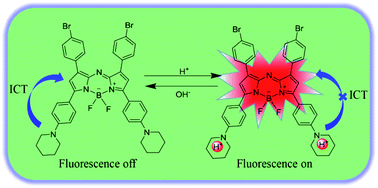A novel near-infrared colorimetric and fluorescent probe based on a piperidine-substituted aza-BODIPY photosensitizer for detection of extreme acidity†
Abstract
In this paper, a novel near-infrared (NIR) colorimetric and turn-on fluorescent pH probe (denoted as Probe 1) has been designed and synthesized based on piperidine-substituted aza-BODIPY, and its ability for sensing pH under extremely acidic conditions has been studied. The maximum absorption band of Probe 1 locates at 811 nm in the NIR region in CH2Cl2 with an intense molar absorption coefficient of the order of 104 M−1 cm−1, which is highly important for biological application. An approximately 156 nm red shift was observed in the absorption of the aza-BODIPY dyes from BDP to Probe 1 (from 655 nm to 811 nm). Dramatic pH responsive absorption and fluorescence changes can be observed under extreme acidity, in conjunction with a visible colorimetric change from purple to blue. Therefore, the detection of pH can be visualized through the color change. Probe 1 with a pKa value of 2.17 could be used in the detection of pH in the range 0.84 to 3.15. Remarkably, this developed fluorescent probe exhibits extraordinary performances including rapid response time, good stability, high specificity and excellent recyclability. This work will provide a new research platform for detecting strong acidity.



 Please wait while we load your content...
Please wait while we load your content...